The United States Grand Prix West was a race held at Long Beach, California, as a Formula One world championship event from 1976 to 1983, on a tight circuit made up of city streets, a challenging and undulating track. The original 1976 layout would still be the dream circuit, with the Le Gasomet and Queen's Hairpins separated by a long sweeping straight along Shoreline Drive.

The start of the race for the first couple of years was held on the north part of the track at Ocean Boulevard which remained part of the circuit every year until the final Formula One running in 1983.
A grueling race that was very punishing on the car and driver and became the U.S.'s answer to the Monaco Grand Prix. The typically sunny and excellent Southern California weather and the Mediterranean climate there made for a very pleasant setting.

The legendary Linda Vaughn, in her prime, at the 1975 Long Beach Grand Prix.

Linda Vaughn at the 1976 Long Beach Grand Prix. Photo by Rainer Schlegelmilch.

Linda Vaughn (right) at the inaugural United States Grand Prix West on March 28, 1976 in Long Beach, California. Photo by Alvis Upitis / Getty Images.

Linda Vaughn with a friend at Long Beach in 1979 attending the event as a Martini-branded girl. Photo by Rainer Schlegelmilch.
In the mid-1970s Long Beach was an austere, post-industrial city, struggling in the shadows of more glamorous neighbours Los Angeles and San Diego.

James and Susan Hunt with Richard Burton.

Susan Hunt and Richard Burton.
In 1976 Susan Hunt shows up at the track with her new love Richard Burton.

Girls, Long Beach, 1976. Photographer Rainer Schlegelmilch.
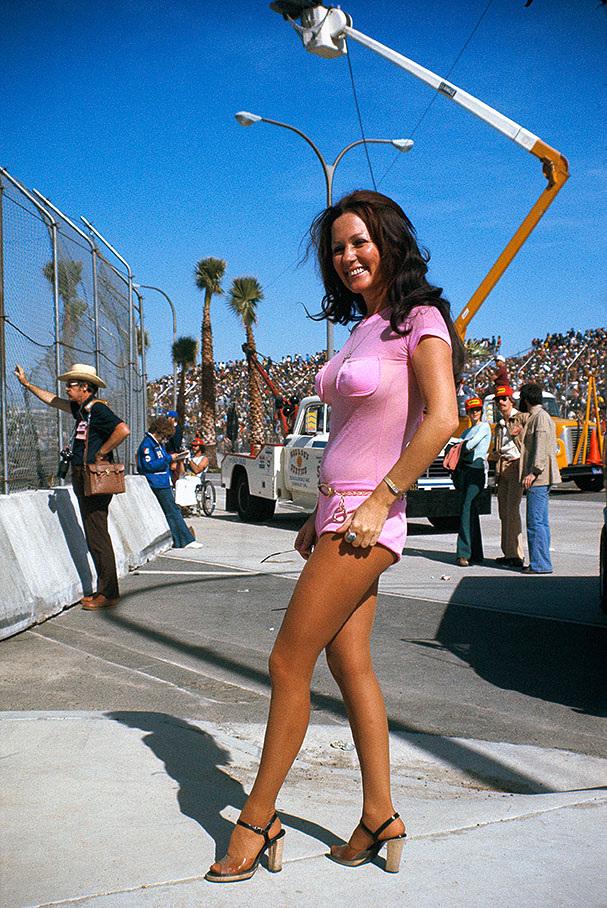
Girls, Long Beach, 1976. Photographer Rainer Schlegelmilch.


Long Beach, 1976, girls. Photographer Rainer Schlegelmilch.

Long Beach 1976, Hans Joachim Stuck. Photo by Rainer Schlegelmilch.

Pits McLaren, above, wide angle, USA-West, Long Beach, 1976. Photographer Rainer Schlegelmilch.

Clay Regazzoni, Ferrari, USA-West, Long Beach, 1976. Photographer Rainer Schlegelmilch.

Clay Regazzoni celebrating on the podium at Long Beach in 1976. Photographer Rainer Schlegelmilch.

Clay Regazzoni, 1st position, on the podium at the USA West Grand Prix in Long Beach on 28 March 1976. Photo by Ercole Colombo.

Clay Regazzoni, 1st position, gets a kiss on the podium at the USA West Grand Prix in Long Beach on 28 March 1976. Photo by Ercole Colombo.
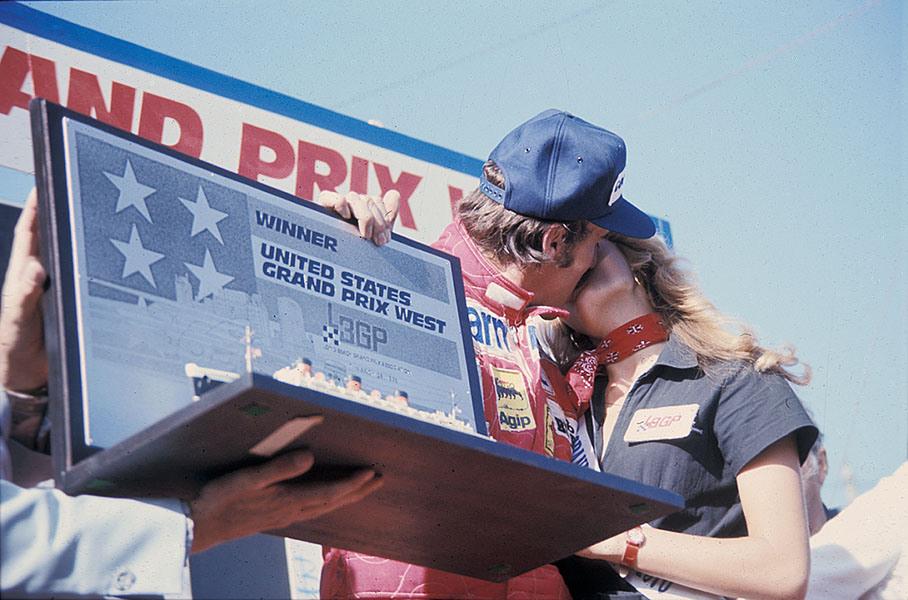
Long Beach 1976. Regazzoni kissing a girl. Photo by Rainer Schlegelmilch.
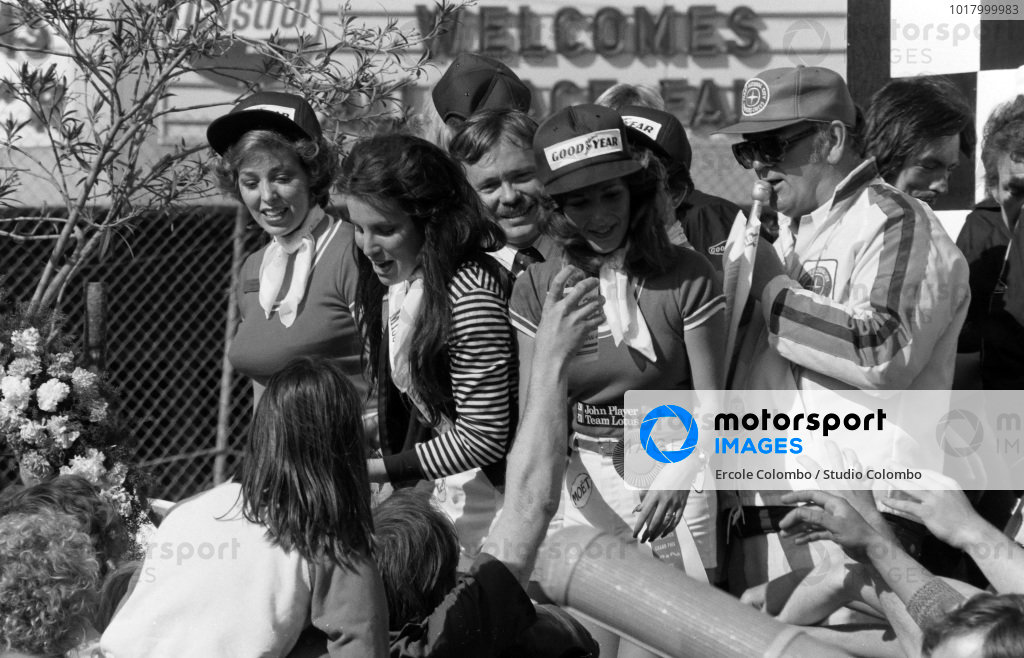
Girls at the 1977 Long Beach Grand Prix. Photo by Ercole Colombo.
In 1977 Andretti in a Lotus took victory, the first for an American in a US GP, Lauda took 2nd and the Wolf driver Jody Scheckter completed the podium with 3rd place.



During the next six years, the international stars continued to visit and with them began the transformation in fortunes for the city.
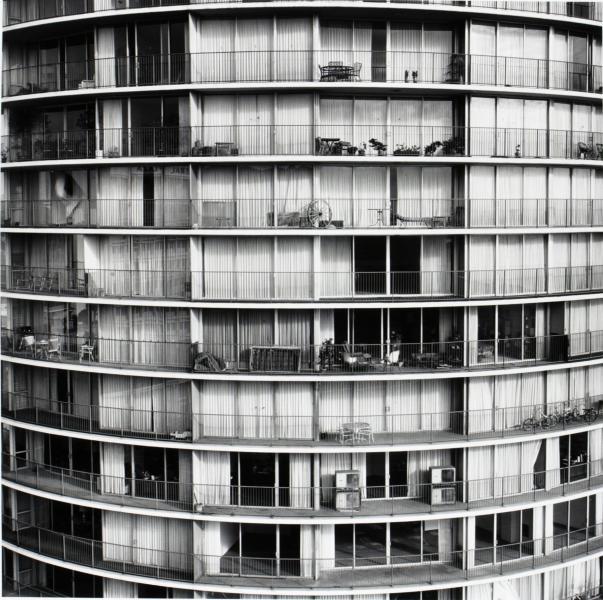
International Tower, Long Beach. Artist Joe Deal 1980.
Downtown, the porn movie houses and boarded-up buildings were being replaced by office buildings, restaurants and gleaming new hotels - a process that continues today.

Patrick Depailler and Ronnie Peterson, 1977, USA-West, Long Beach. Photographer Rainer Schlegelmilch.

Jochen Mass and grid girls, 1977, USA-West, Long Beach. Photographer Rainer Schlegelmilch.

Jochen Mass kisses a promotion girl on the grid, US GP 1977. Photographer Rainer Schlegelmilch.
Part of the interior of the circuit is the 13,600 seat Long Beach Convention Center which also doubled as the pit paddock.
In 1978 the start/finish line was moved to the long sweeping Shoreline Drive at the bottom of the circuit, so the race distance was 79.5 laps.

The podium of the 1978 Long Beach Grand Prix.

The podium of the 1978 Long Beach Grand Prix.

In Long Beach though, Andretti (right) had to settle for the soon to be obsolete Lotus 78 which although bettered most was not enough to prevent Carlos Reutemann (centre) taking victory for Ferrari in 1978, with Patrick Depailler (left) third for Tyrrell.
The race was won by Argentine Carlos Reutemann.

The crowd looks on as celebrity participants race Indy cars on the streets during the Long Beach Grand Prix in 1979 in Long Beach, California. Photo by Maureen Donaldson / Michael Ochs Archives / Getty Images.
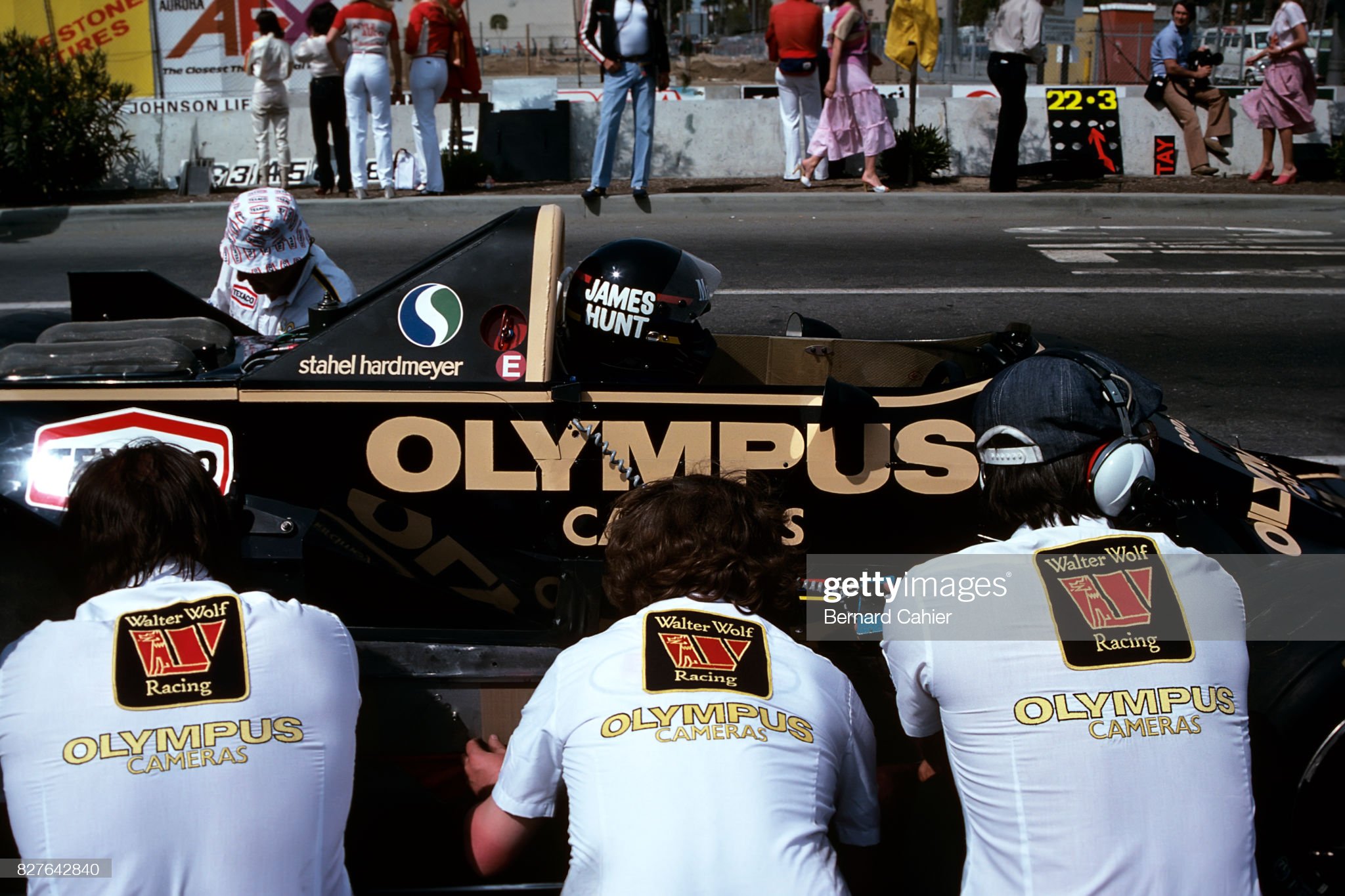
James Hunt, Wolf-Ford WR7, Grand Prix of United States West, Long Beach, 08 April 1979. Photo by Bernard Cahier / Getty Images.
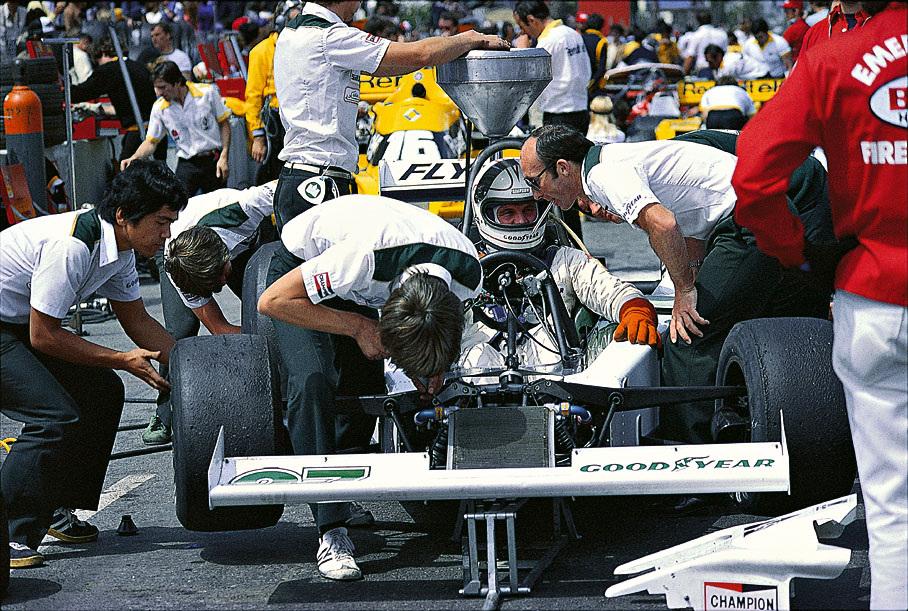
Alan Jones refuelling his Williams, USA-West, Long Beach, 1979. Photographer Rainer Schlegelmilch.

Villeneuve (centre) celebrates his victory on the podium, having triumphed by 30 seconds in front of Ferrari team-mate Jody Scheckter (right) and Williams' Alan Jones.
In 1979 Villeneuve won from his teammate Scheckter.

The podium of the 1979 Long Beach Grand Prix.

The podium of the 1979 Long Beach Grand Prix. Photo by David Phipps.

Fans, USA-West, Long Beach, 1979. Photographer Rainer Schlegelmilch.

Hans-Joachim 'Striezel' Stuck, US GP Long Beach, 1979. Photographer Rainer Schlegelmilch.

Jacques Laffite, USA-West, Long Beach, 1979. Photographer Rainer Schlegelmilch.
In 1980 Clay Regazzoni in an Ensign crashed appallingly when his brakes failed at 180 mph at the end of Shoreline Drive. While going off the course, the Swiss driver hit Ricardo Zunino's crashed and stationary Brabham at full speed.


He then hit the wall next to the track and went straight-on past Queen's Hairpin and crashed into retaining tire barriers head-on, still moving extremely quickly.

Regazzoni's helmet after the accident.
This devastating accident left him paralyzed from the waist down; he never raced in F1 again.

Jochen Mass and friend, Long Beach, 1980.

Jochen Mass and friend, Long Beach, 1980.

Piquet was all smiles as he received a winning wreath in front of second place Fittipaldi (left) and third place Riccardo Patrese.

Podium ceremony after the 1980 US GP (West) in Long Beach. Third placed Emerson Fittipaldi, race winner Nelson Piquet and second placed Riccardo Patrese. Photographer Rainer Schlegelmilch.
Nelson Piquet dominated that race weekend with his countryman Emerson Fittipaldi taking 3rd.

The 1981 Long Beach weekend was a frustrating one for Lotus. Having debuted the Lotus 88 - an innovative twin chassis design - following practice it was protested against by other teams leading to it quickly being banned before qualifying.
In 1981 one of the left handers at Pine Avenue was re-made from two corners to one corner.

Jones celebrates victory on the podium but Reutemann cuts a frustrated figure. At the next race in Brazil, Reutemann again led but this time refused to give way to Jones before taking a controversial win.

Jones celebrates victory on the podium but Reutemann cuts a frustrated figure. At the next race in Brazil, Reutemann again led but this time refused to give way to Jones before taking a controversial win.

Nelson Piquet celebrates his 3rd place at the Long Beach GP, the 1981 season opener. Photographer Rainer Schlegelmilch.

The 1980 F1 World Champion Alan Jones and two Toyota-girls, Long Beach, US-West Grand Prix, 1981. Photographer Rainer Schlegelmilch.
After some laps Jones slipped by to take the lead, which he held until the end.

For 1982 Long Beach was heavily modified. The fastest part of the circuit on Shoreside Drive was slowed down by a short right-left section, while Pine Avenue was ditched after Queen's Hairpin became a 90 degree right hander into a left. Above Nigel Mansell shares thoughts with his Lotus team before missing out on the points with a seventh placed finish.
For 1982, there were more changes to the circuit, which removed Queen's Hairpin and most of Pine Avenue.

Former F1 World Champion James Hunt with his wench in 1982. Photographer Rainer Schlegelmilch.
A whole new section of road was used for the race; the Clos esses were changed and there was a chicane placed on Shoreline Drive. Thus, the race distance was shortened from 79.5 to 75.5 laps.
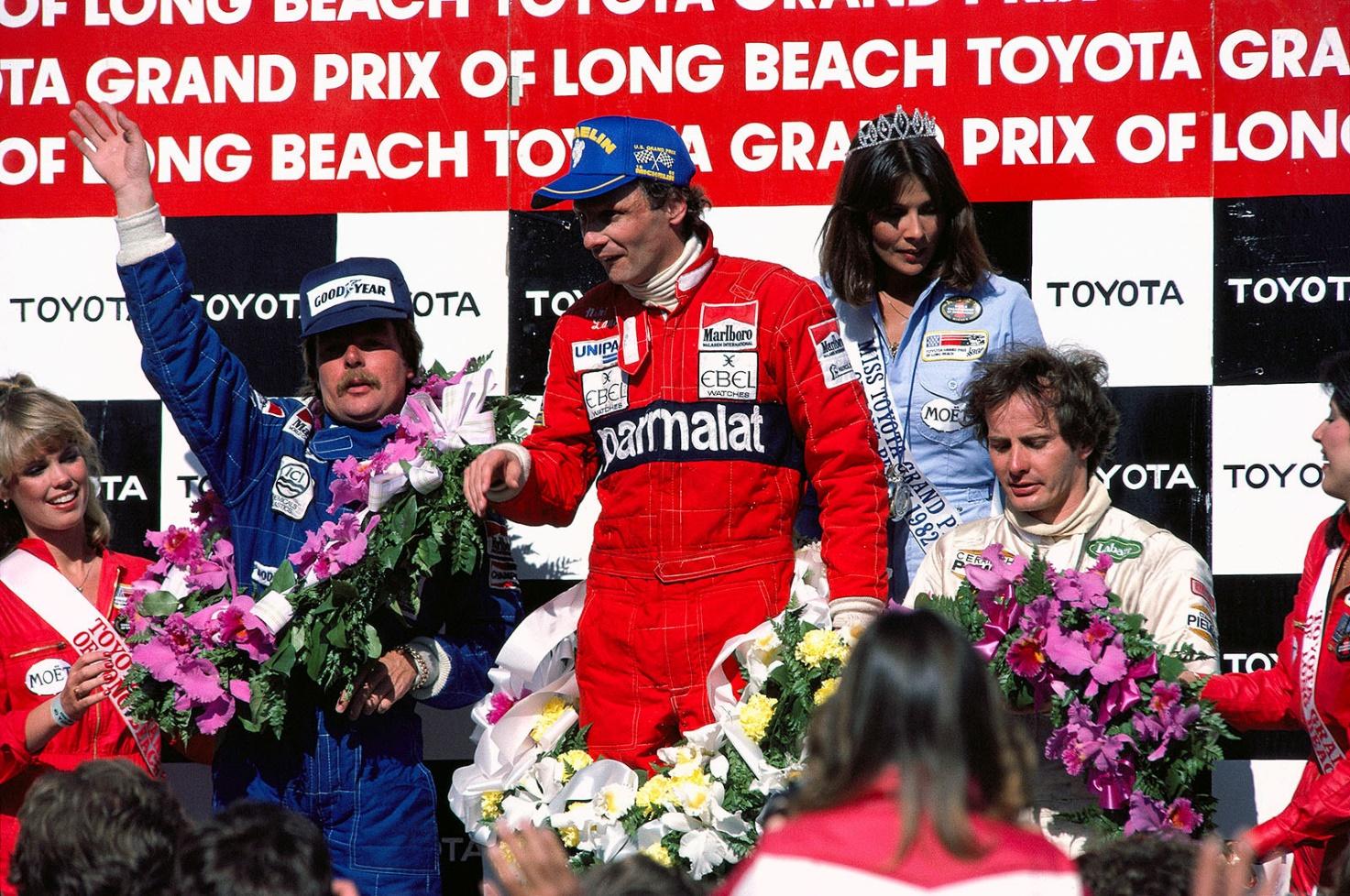
Long Beach 1982. Keke Rosberg, Niki Lauda (middle) and Gilles Villeneuve are the top three drivers on the podium. Lauda won his 1st GP just three races after his comeback in F1 that season. Photographer Rainer Schlegelmilch.
Niki Lauda won the race from Finn Keke Rosberg in a Williams and the Finn battled fiercely with Villeneuve in his more powerful turbo-charged Ferrari;

Gilles Villeneuve, Ferrari, Long Beach, 1982. Photographer Rainer Schlegelmilch.
Villeneuve finished 3rd but was disqualified because of the two wings mounted on the back of his car.

Ferrari team-mates Didier Pironi and Gilles Villeneuve in 1982. Photographer Rainer Schlegelmilch.
1983 Long Beach.

1983 Elio de Angelis, Lotus 93T Renault, in the pit lane. Tony Rudd and Peter Warr work to the right of the car.

Rene Arnoux, Ferrari, on Sunday, March 27, 1983. Photographer Rainer Schlegelmilch.
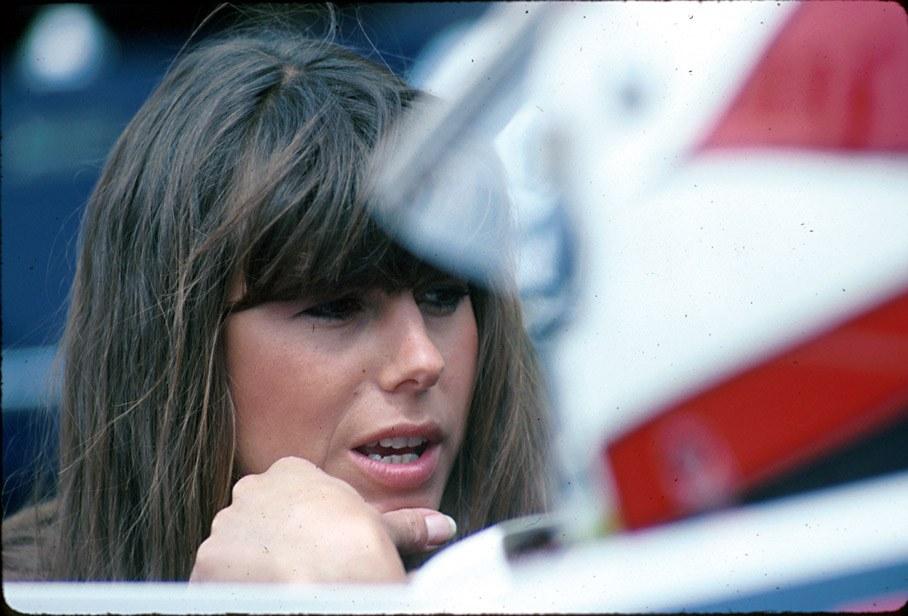
Sylvia Piquet, Long Beach 1983. Photographer Rainer Schlegelmilch.
In the final event in 1983 the elevated Ocean Boulevard and the steep runs up to and down from it, were no longer used; and Seaside Way, a road (level with the rest of the circuit) that runs parallel to Ocean Boulevard, was used instead. The revised circuit also included a number of tight turns built around the Convention Center and a slightly shortened Le Gasomet hairpin. The pits were moved down to Shoreline Drive.



Long Beach, California, USA. 25th - 27th March 1983. John Watson (McLaren-Ford MP4-1C) and Rene Arnoux (Ferrari 126C2B). Copyright LAT Photographic.

John Watson, Long Beach GP, 27th March 1983. Shutterstock editorial.
John Watson won from 22nd place on the grid and his teammate Lauda finished 2nd.

The first corner moved to the opposite side of the track in 1978 at the end of the fastest section and remained there for the rest of F1's tenure. Between 1978 and 1981 it was known as Queen's hairpin as the circuit turned back on itself towards Pine Avenue as Nelson Piquet leads the field here for Brabham in 1980. For 1982 and 1983 it became a 90 degree right turn.
When F1 raced at Long Beach: US GP West, 1976-1983. By Károly Méhes. March 22nd, 2019.

By the mid-1970s, the United States Grand Prix had found its annual home at Watkins Glen in upstate New York. Then a new venue joined the fray. The inaugural USA West Grand Prix was held in Long Beach, California from 1976.

Regazzoni wins at long beach in 1976.

Clay Regazzoni at Long Beach in 1976.
The new race was immediately a hit. The Californian weather in March was perfect when compared to the melting heat at the South American races in January. It may have been a street circuit, but this was America and Long Beach was much wider than Monte Carlo. The surroundings weren’t bad either, thanks to the backdrop of the Pacific Ocean. The race was also popular with everyone from the Hollywood elite, including Paul Newman, to Miss California.


One of the trickier corners on the circuit was the first one as following the start straight a right turn would immediately throw the car into a short but sharp decline down Linden Avenue, as demonstrated here by Jody Scheckter, whose unbalanced Tyrrell has its right front off the ground. Spectators on the left enjoy the view from a building that has since been demolished.
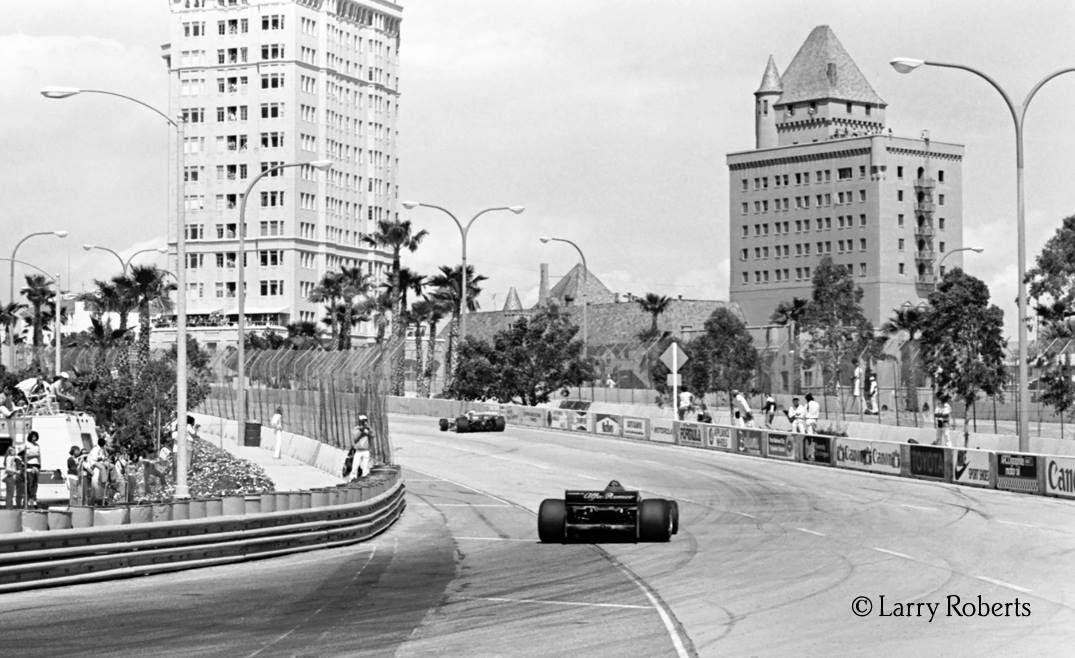
’76


James Hunt enjoys the sun and the company in the build up to the inaugural US GP West in 1976.
It was a clean sweep for Ferrari at the inaugural event in 1976. Clay Regazzoni upstaged his more fancied teammate Niki Lauda. The Swiss driver seemed to really get it together just once per season and this was his weekend. Regazzoni put his Ferrari 312T on pole and comfortably led home Lauda, who probably didn’t mind so much after his main Championship rival James Hunt was eliminated in an accident on the 3rd lap.
’77
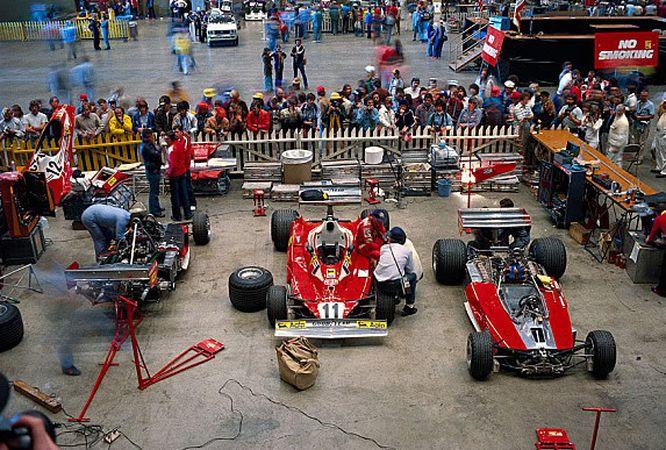
Box Ferrari, Long Beach 1977. Photographer Rainer Schlegelmilch.

Another view of Cook's Corner from 1977 shows Gunnar Nilsson's Lotus followed by Jean-Pierre Jarier - with the latter eventually denying Hunt his points finish. Locals watch the drama from every floor of a nearby balcony in a race won by USA's Mario Andretti who took advantage of Jody Scheckter's slow puncture to take the lead with four laps remaining.

James Hunt runs into trouble at the start of the 1977 race, as the world champion's McLaren climbs over British compatriot's John Watson and his Brabham as the duo enter turn one (Cook's Corner) on the opening lap. Hunt damaged his suspension but was able to continue and missed out on a point by just two seconds after finishing seventh.
The 1977 edition of the race was the only time a local driver took the chequered flag – Mario Andretti led home Niki Lauda after the Austrian had scored his first pole since almost losing his life at the previous year’s German Grand Prix.

Andretti (left) would only finish second a year later as the American engages in discussion with his Lotus team including boss Colin Chapman (centre). Despite missing out on victory, Andretti would benefit hugely from the introduction of the innovative and dominant Lotus 79 later in the season which fired him towards his sole world championship.
Still, Andretti was unstoppable, enjoying a very popular victory in front of a partisan crowd. As he said after the event, “it is one of the nicest moments of my career, even more satisfying than winning Indianapolis and really gratifying to have so many people pulling for me.”
’78
It was Ferrari’s turn again in 1978. Carlos Reutemann and his young team mate Gilles Villeneuve locked out the front row of the grid for the Scuderia. The Canadian novice, taking part in only his seventh GP (and sixth for Ferrari), led commandingly till the 39th lap when his patience deserted him as he lapped former winner Regazzoni (this time with Shadow) and they crashed. Reutemann inherited the win ahead of Andretti and Frenchman Patrick Depailler in the six-wheeler Tyrrell.
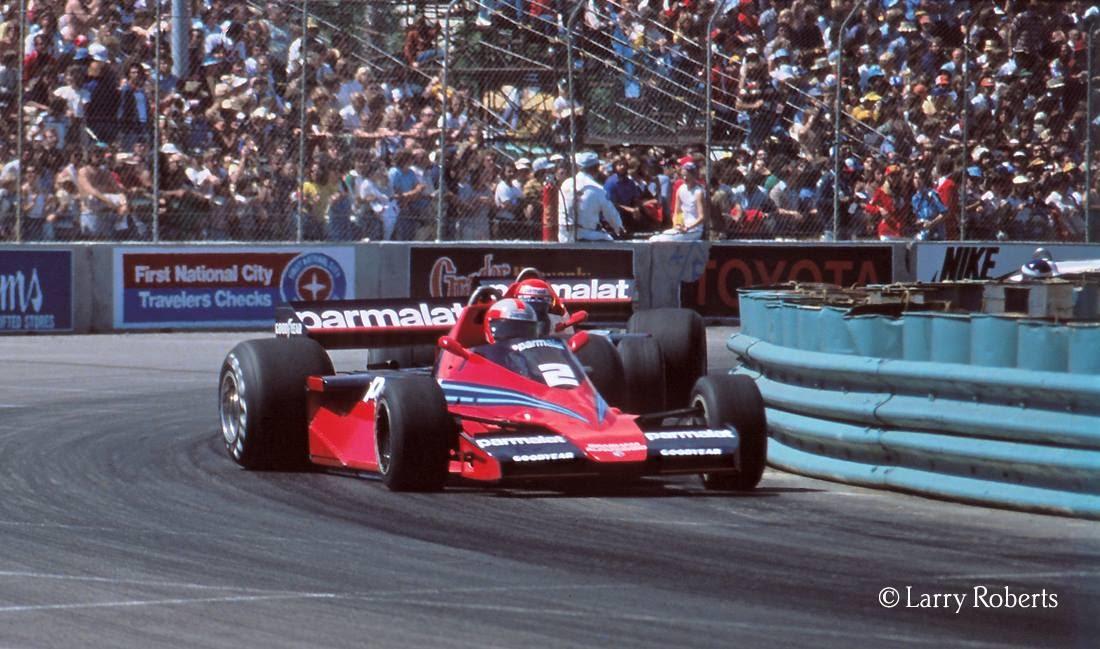
’79
Villeneuve got his win one year later. The Canadian qualified his Ferrari 312T4 on pole and swept home for a lights to flag victory. Teammate Jody Scheckter came second and Alan Jones in the Saudia-Williams was third. Niki Lauda was lucky to survive a scary first-corner accident (see below) when Patrick Tambay rear-ended Brabham, almost taking off the Austrian’s head.


’80



By 1980 James Hunt had retired from F1, but being without a drive and sustaining a broken leg from a skiing accident wasn't going to prevent the Brit from making the trek back to California for the US GP West as he is pushed around in a wheel chair.

The final corner was also a hairpin leading on to the start of Shoreline Drive that was known as Le Gasomet. Piquet shows the way to rivals in 1980 as the Brazilian is followed by Emerson Fittipaldi and Ferrari world champion Jody Scheckter.
In 1980, Nelson Piquet planted his Brabham on pole and just like Villeneuve the previous year led all the way home to score his maiden Grand Prix win. It was a changing of the guard for the Brazilian: the first Brazilian World Champion Emerson Fittipaldi enjoyed his last appearance on the podium with a fine third for his eponymous team. Reigning World Champion Jody Scheckter finished fifth – the only points he earned for the whole 1980 season. The saddest news of the race came when veteran Clay Regazzoni, driving for Ensign, had a brake failure and crashed heavily into a concrete wall. The popular 41-year-old Swiss driver was paralyzed from the waist down as a result.
’81
Riccardo Patrese took a surprise pole for Arrows in 1981. Driving the first turbo-powered Ferrari, Villeneuve led briefly before World Champion Alan Jones led home his Williams teammate Carlos Reutemann for an easy win, with Nelson Piquet third for Brabham.

’82
Niki Lauda made a welcome return to the grid with McLaren in 1982 after a short-lived retirement. He hadn’t lost any of his form at age 33 and was on the pace from the season-opener in South Africa, silencing several sceptical voices in the Paddock. Andrea de Cesaris took pole for Alfa Romeo, but Lauda stood beside him. Lauda bided his time after the start, overtaking De Cesaris on lap 15 after the young Italian made a mistake.
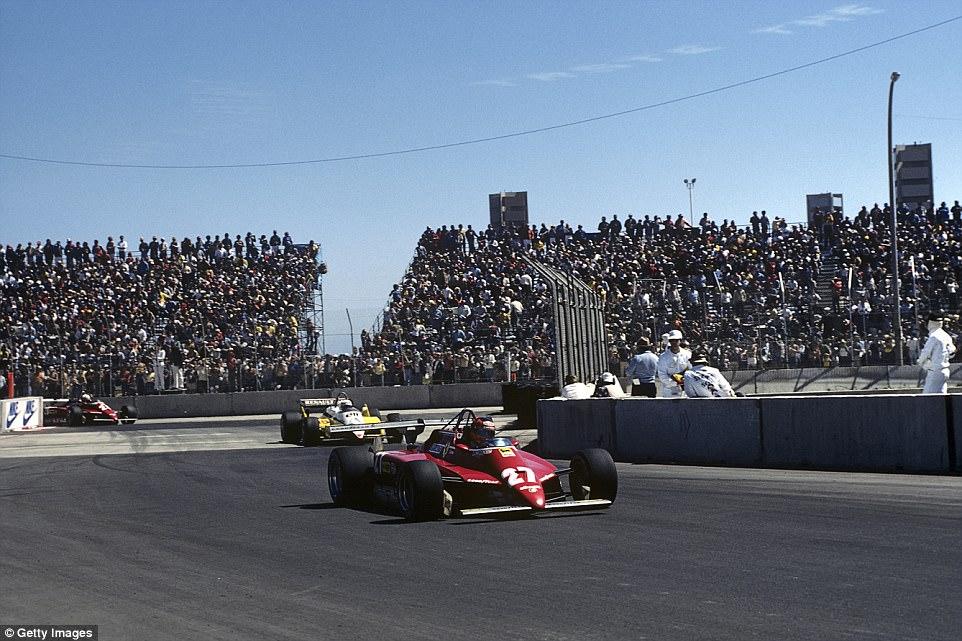
Gilles Villeneuve tours the circuit on his way to third in 1982 but was later disqualified after protests against the Ferrari rear wing were upheld. For 1983 the track was changed again, ditching the Ocean Boulevard straight in favour of the street south on Seaside Way. F1 hasn't returned to California since due to a long running Indy Cars deal and won't return anytime soon.
The Austrian pulled away for the first win after his comeback. Rosberg came home second and Villeneuve was third, but the Canadian was later disqualified for his novel twin rear wing and the position went to Patrese.
’83

Long Beach, Sunday, March 27, 1983. Miss Toyota GP promotional models in front of a Toleman in the pits. Photographer Rainer Schlegelmilch.
The final United States Grand Prix West in 1983 proved that miracles can happen in Formula 1 as John Watson won from 22nd on the grid for McLaren.

1983 Long Beach. Andrea de Cesaris', Alfa Romeo. Photographer Rainer Schlegelmilch.

Long Beach. Sunday, March 27, 1983. Photographer Rainer Schlegelmilch.
The Ferraris of Tambay and Arnoux started from the first row, followed by the Williams’ of Roberg and Laffite. Watson started 22nd for McLaren, one place in front of teammate Lauda. It was a race of attrition up front as Tambay, Arnoux, Rosberg, Laffite and Patrese battled hard. Meanwhile, the two McLarens moved slowly through the field, benefiting from the mistakes of others, with Watson taking the lead from Lauda after halfway distance and not giving up till the flag.
Here’s what Watson had to say afterwards: “after that dismal practice, Michelin were as perplexed as we were. I decided to take a gamble and try the tyre compound we had used in Detroit and it worked.” Watson had also won in Detroit the year before from a lowly 17th on the grid. It remained Watson’s final F1 victory and the last Grand Prix in Long Beach.

Chris Pook was the founder of the United States Grand Prix West and shows a map of the Long Beach circuit in 1980, appearing to point at the second established start-finish straight at Shoreline Drive on the clockwise track.
Promoter Chris Pook found F1 too dangerous and expensive and switched his interest towards IndyCar.
Videos



Comments
Authorize to comment